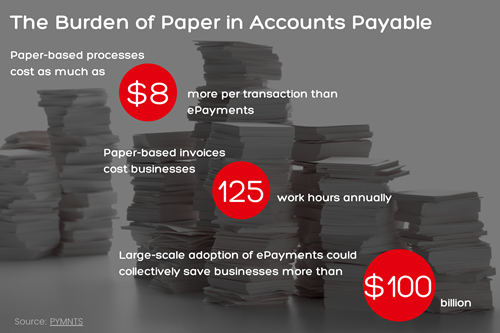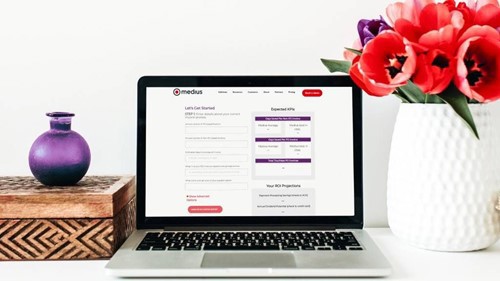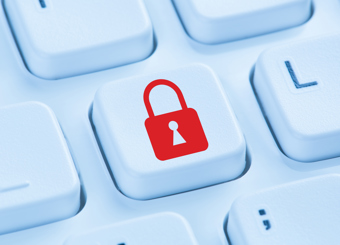The Case for the AP Digitization Journey
Modern businesses are all either considering digital transformation or already in the process of doing so. What’s more, over 46% of accounts payable professionals are interested in adopting automated payment solutions.
So what does digitizing accounts payable mean?
Adding automation to your payables processes is a way to capitalize on the efficiency and cost-cutting benefits it brings in, while also cutting fraud and increasing access to payment data. Virtual cards in particular are a rising payment method that you can’t afford to overlook.

Virtual Cards On The Rise
Due to the state of the world right now, business adaptability to work remote is crucial. Virtual cards (v-cards) are uniquely positioned to not only make this possible but to make this an advantage in the future. There are a lot of great reasons for accounts payable departments to use virtual cards.
Virtual cards in B2B Payments enable:
- Rebates for each dollar spent
- Full control of the payment process
- Card reconciliation reporting in your ERP
- Increased security
This is just the beginning of what v-cards offer for businesses that use them. It’s more imperative than ever as our workforce becomes more mobile. The ability to process payments from anywhere in the world is what will set you apart from your competition.
Harvard is predicting that COVID-19 could cause periodic shutdowns and stay-at-home orders through 2022. This means that the manual process of printing and mailing out paper checks is no longer a viable option. Doing the same from your employees’ homes as they work remotely isn’t the answer either.
According to a study by Master Card, reducing check processing by 10-50% will result in $1.3-58.3 billion in savings annually.
Automated Clearing House (ACH) is a method for settling invoices — if your suppliers accept ACH — but virtual cards are the better strategic option for both payers and suppliers. It’s the ultimate B2B payment method.
For a payer, virtual cards generate revenue in the form of cashback — a feature that is more attractive than ever as companies look to offset the negative impact they’ve experienced because of 2020s Black Swan event.
For a supplier, virtual cards offer increased security that doesn’t require them to alter their card acceptance workflows to take advantage of.
For both, it means a more streamlined reconciliation and reporting process.
Recent studies have found that 33% of companies expect their usage of ePayables and virtual cards to increase, and more than 30% of companies have already implemented accounts payable (AP) automation.

The Challenge of eInvoicing
For many suppliers, the new trend of working remotely has driven their accounts receivable (AR) departments to email invoices out to their clients. It's driven accounts payable (AP) departments to send staff home with check printers so they can handle paper checks from a home setting or to contract out back-up check printing.
This not only provides a false sense of digitization and adaptation to remote environments — it leaves you vulnerable to fraud.
“There’s a misperception that receiving an invoice as a PDF document attached to an email is an electronic invoice,” Neal Anderson, our VP of payments strategy, told PYMNTS in a discussion. “That’s not the case. That PDF is probably still going to be printed out at some point.”
The push towards digital invoices isn’t just down to current events. It is also motivated by that fact that it saves money and time.

Forward-thinking companies are already on the road to automating payments, and that is a trend that is becoming increasingly widespread. The need for payment automation and increased remote access, previously a one to three-year project, is now at the top of many to-do lists.
According to Business Insider, 44% of businesses are looking to add automation to their payables processes as a way to capitalize on the efficiency and cost-cutting benefits it brings in, while also cutting fraud and increasing access to payment data.
Too many companies are sending screenshots or scans of invoices via email, which is an insufficient band-aid solution that comes with a high-risk of fraud. Adopting electronic invoices automates the process and enables remote AP.
Our invoice automation solution transforms invoices into a digital workflow with a 99% accuracy rating while also eliminating double work, mundane tasks, and errors that come from manual work.

3 Essential Buyer-Seller Benefits
Digitizing AP is a long overdue conversation that the current economic environment has brought to the table. It’s an opportunity that shouldn’t be overlooked — one that will optimize operations for the future.
1. Increase Operationality With the Vendor Portal
Automated payment processes that can be approved, processed, and tracked in a Vendor Portal are more secure and safe to use. This pays off for both buyers and sellers.
Our Vendor Portal is:
- Secure from cyber crime
- Designed with suppliers and vendors in mind
- Available remotely 24/7
Security is likely the most critical feature since according to Security Studio, 65% of organizations say it’s hard to manage cyber security with their vendors. Despite this vulnerability, 71% also say that they expect their companies to become more reliant on vendors and suppliers in the future.
2. Digitization Equals Enhanced Efficiency
Digitally transforming your AP department makes your team more efficient and ensures your suppliers and vendors get their payments on time.
Per findings from Smartsheet, 25% of the work week in a finance department is spent on repetitive and manual tasks. This roughly equates to 10 total weekly hours per employee spent on manual tasks. That math, those 10 hours per week, would add up to a significant amount of time.
Automation allows you to allocate that time to better purposes and high-value tasks that will have a positive impact on your business. Plus, these tasks are also more rewarding for your staff.
3. Open New Lines of Revenue
Modern payment methods like virtual cards open new lines of revenue, reduce the cost of paper invoice generation, and strengthen buyer-supplier relationship through enhanced data connectivity.
They also enable you to join the new high tech, low touch economy. Consumer payments have long been low touch thanks to payment apps on smart phones and it’s past-time that B2B payments catch-up and leverage no touch payments.
With the right virtual card partner, you can turn spend into profit with 1% cashback on AP spend via monthly rebates.

Conclusion
Payment digitization is the next frontier for businesses. Thankfully, it’s never been easier.
Today is the day to begin the journey towards AP automation. Keep your current processes and ERP and digitize your invoices and payments at no capital expense. It's essential for businesses to evolve by using technology that contributes to future success. Choosing the right partner can be the key to enabling just that.
Get in touch today to start your digitization journey.
Interested in more information? Check out our other resources:






